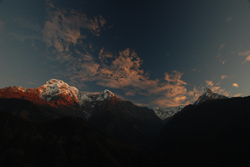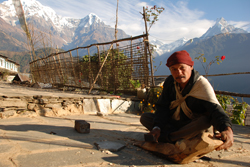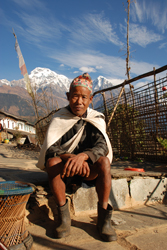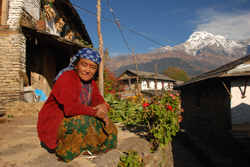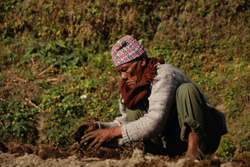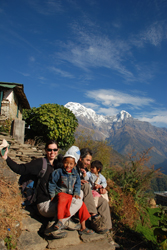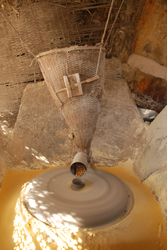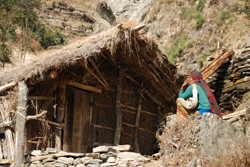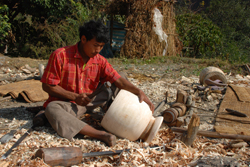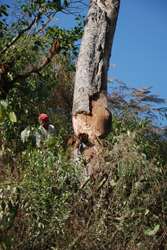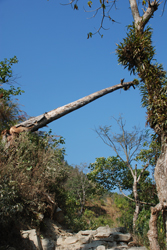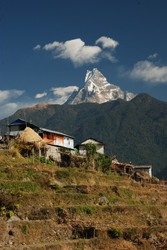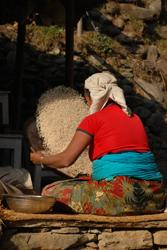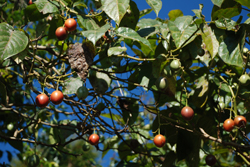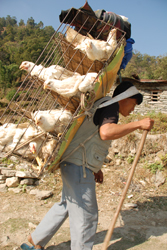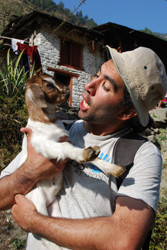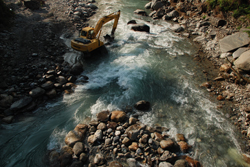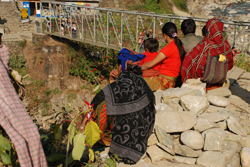Ghorepani Trek Day 5: Back To Pokhara
16 December, 2008, 02:12 am in "Nepal"
Since the town of Ghundruk gets light in the morning and not the afternoon, we talked Dipak into taking a walk with us around Ghundruk before we hiked back to Nayapul. The morning sun lit up the buildings beautifully. The people of the town were enjoying it as well, sitting in front of their houses on flagstone patios and doing morning chores. Rowshan saw a man carving a groove in a new wooden plow. We all joined him. Dipak found out that they have to make a new plow every 15-20 days because they break often from striking stones. The plow takes 2 days to make: 1 to go into the jungle and find the tree for it and then next to carve it.
I should mention how great our guide, Dipak was. He let us set the pace and once he knew Rowshan was interested in photographing butterflies, he searched for them as well and pointed them out. We could tell he was interested in the culture of people in the villages and would talk to them about what they were doing, if not for his own information, then so he could explain in more detail to customers. Often it seems guides are content to just point out the path and say a few set things about the surroundings. If you are in Pokhara and need a guide, contact Dipak at Pristine Mountain Tours on Lakeside.
A little farther on we met some children-- one wearing a plastic bag for a hat. They posed for photos and followed us as we walked down the path. The boy with the bag on his head held his arms out to me. I picked him up and swung him around a bit-- I guess that's what you're supposed to do with little kids right? His name was Aziz and his sister was Barsa. They sat with Rowshan and I-- Aziz on my lap, Barsa on Rowshan's. She tentatively touched his stubble and chest hair peeking out from his shirt-- curious because the men here don't have much facial or body hair. Soon their mother called them away. We eventually, and slightly unwillingly left Ghundruk which seemed like such an idyllic place with its flowers, colored wooden windows, and amazing backdrop of the Himalayas.
A little farther on we met some children-- one wearing a plastic bag for a hat. They posed for photos and followed us as we walked down the path. The boy with the bag on his head held his arms out to me. I picked him up and swung him around a bit-- I guess that's what you're supposed to do with little kids right? His name was Aziz and his sister was Barsa. They sat with Rowshan and I-- Aziz on my lap, Barsa on Rowshan's. She tentatively touched his stubble and chest hair peeking out from his shirt-- curious because the men here don't have much facial or body hair. Soon their mother called them away. We eventually, and slightly unwillingly left Ghundruk which seemed like such an idyllic place with its flowers, colored wooden windows, and amazing backdrop of the Himalayas.
Out of town we stopped at a little building located near a tall waterfall. The mill hut was made of branches bound together with bamboo straps. The walls were of woven grass and branches. Inside a large millstone was turning powered by water from the waterfall. Corn was in the process of being ground but a layer of white powder suggested rice was also ground there. Above the cliffs from which the waterfall plummeted, eagles were circling.
At a village we saw a young man carving water jugs from large chunks of wood. He was using an ax but there were other rough metal tools which he used to somehow make a smooth, finely made jug. A drill type thing for hollowing the jug was operated by leather straps.
The path we walked was mostly stone steps leading down the mountainside. We seemed to be getting into warmer drier climate. The road reached the river level, then rose a little around an area where the road had washed out. A mule train went by. Then as we continued, we heard the sound of an ax. Dipak called out and the woodsman stopped. We saw he was chopping down a dead tree near the road. We rushed past then watched as within a few more chops, the tree fell down across the path.
The path led by villages where people were working, and rice paddies and fields where water buffalo grazed. Butterflies flitted from stones to flowers. One thing kind of interesting about Nepal is some of the giant plant life. Rhododendrons that appear as chest high bushes in the US are 20ft tall trees here. Poinsettias-- seen in little flower pots in the US grow on 10ft tall bushes. The tomatoes we are used to seeing also on small fragile bushes grow on sturdy trees here.
We also saw lots of porters. Even though it looks like a road has been put in, there is still no way for cars to get across the river to the wide path. Dipak said it was put in by a hydroelectric company which wants to start work there. In the meantime, everything that goes to the villages is carried by either mule or porter. We saw 2 porters carrying cages of sickly looking chickens, probably destined for the hotels to serve to tourists. The local chickens that live free ranged scratching by the paths are some of the fattest and healthiest looking chickens I've seen. Beautiful roosters with glistening feathers crow proudly in the sun.
We suddenly were back at Birathanti and the trek was over. We crossed the metal suspension bridge where many people were assembled watching a bulldozer scoop rocks from the river and pile them on land. (All the suspension bridges we saw in the area had signs saying they were built by the Gurkha regiments.)
Back in Pokhara, we went to the Asian Tea House for dinner. There we met Craig and Jennifer, 2 Americans from Miss. who are also doing a RTW trip though are going the opposite direction from us. The delicious dinner and great conversation made us forget how tired we were.
Comments
- Comments
Powered by My Blog 1.69. Copyright 2003-2006 FuzzyMonkey.net.
Created by the scripting wizards at FuzzyMonkey.net..
(Code modified by Rowshan Dowlatabadi)
Created by the scripting wizards at FuzzyMonkey.net..
(Code modified by Rowshan Dowlatabadi)


